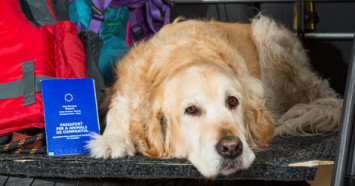
When you have pets, you can’t afford not to have a plan in case of emergency. Have you thought through different emergencies and how you would keep your pet safe? Depending on where you live, you’re at risk for various natural disasters in addition to those emergencies that know no geographic bounds, like house fires.
While we can’t plan for everything, we can do our best. Read on for tips and ideas for including your pets in your emergency plan.
1. Put rescue stickers on your windows/doors.
One of the best ways to communicate to emergency personnel that you have pets is by affixing alert stickers to your doors and/or windows. You can get them for free from the ASPCA, or purchase your own if you want something fancy.
2. Do not wait to evacuate or make a plan.
Don’t put off making a plan any longer. You’re reading this so that’s a good first step! Same thing when the actual emergency arrives: don’t wait to evacuate or move to safety. Allow yourself plenty of time. Even if the evacuations aren’t mandatory, consider starting the process of leaving anyway. Evacuating with pets takes more time than you may realize, and if you wait until the last second, it may be too late.
3. As soon as you get the inkling that conditions will be bad, secure your animals.
They can spook easily during a scary time like this, and you may lose them in the chaos. Make sure you have plenty of crates, carriers, cages, and whatever types of enclosures necessary. Improvise only if there are no other options.
4. Have two evacuation routes planned.
Whatever the emergency, consider how you would safely get out of and away from your house, and possibly out of your neighborhood or town. Make sure you have multiple ways to get out of your house and that you have at least two evacuation routes out of your area.
5. Make sure your pet’s collar and tag (or other ID) are current and in good condition.
Take the time to inspect their ID tags regularly, especially at the first signs of possible emergencies. Make sure their name is visible and phone number is easy to read. Also make sure their microchip info is current and that you have a second contact listed (consider listing someone who lives out of the area in case local communications go down). For large animals, you can spray paint your phone number or other ID information onto their bodies.
6. Make and have a pet emergency supply kit handy.
This includes general as well as species-specific supplies, such as heat lamps, soaking dishes, salt licks, and any other supplies vital to keep your pet alive. See our pet emergency evacuation kit article for more information.
7. Have current vaccinations records from your vet in case you need them for boarding or other housing situations.
Your vet can provide you with copies at any time. Remember to ask for these at your next visit and put them in your pet’s emergency kit.
8. Identify a pet-friendly location you can go to if needed.
Well in advance, when you’re not feeling the stress of a possible life-threatening emergency, research hotels, AirBnBs, and other types of shelters that would welcome you and your pets. Also make a list of family members and friends who you could stay with. Make sure to have a list of both local contacts and those that are further afield. And remember to list their phone numbers in case something happens to your phone and you don’t have your contacts at your fingertips.
9. Make sure you have a few people who can evacuate your pets if you are not home/able to get home.
Experiencing an emergency is scary enough, but if your pets happen to be without you when disaster strikes they will need someone to help them. Identify and ask a handful of people who would agree to and be able to go to your house and evacuate your pets if needed. Make sure to do this before a disaster.
10. If you have many and/or large animals, make sure you have a vehicle/trailer big enough to hold them.
If you need to rent one, make sure you do that early. Think about if you will need help evacuating your brood and find experienced help ahead of time. Also, make sure your large animals are trained to go into a trailer. This will be a life-saver.
11. If you are riding out the disaster at home, keep your pets with you.
Do not let them wander free in the house or outside. Choose a room for the entire family to stay in. Close off all areas where small pets could get stuck if they get frightened and try to hide. Secure your pets in crates or on leashes.
Note: If you cannot evacuate large animals/farm animals safely, and you choose to let them stay, you should either shelter them or turn them loose outside. Never leave an animal tethered outside during an emergency.
Facing a disaster is scary, don’t make it harder on yourself or your pets by being unprepared. Take time now to think, plan, and prepare. It could save your best friend’s life one day.